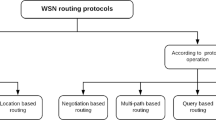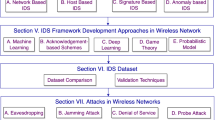Abstract
Mobile ad hoc networks (MANETs) become more and more popular and significant in many fields. However, the important applications of MANETs make them very attractive to attackers. The deployment scenarios, the functionality requirements, and the limited capabilities of these types of networks make them vulnerable to a large group of attacks, e.g., blackhole attacks. In this paper, we propose a cluster-based scheme for the purpose of preventing blackhole attacks in MANETs. In our scheme, we firstly present a novel algorithm that employs a powerful analytic hierarchy process (AHP) methodology to elect clusterheads (CHs). Then CHs are required to implement the blackhole attacks prevention scheme to not only detect the existence of blackhole attacks but also identify the blackhole nodes. Simulation results show that our scheme is feasible and efficient in preventing blackhole attacks.














Similar content being viewed by others
References
Jurdak, R., Lopes, C. V., & Baldi, P. (2009). A survey, classification and comparative analysis of medium access control protocols for ad hoc networks. IEEE Communications Surveys and Tutorials, 6(1), 2–16.
Remi, B., Radu, S., & Olivier, F. (2005). Management of mobile ad hoc networks: information model and probe-based architecture. International Journal of Network Management, 15(5), 335–347.
Christos, P., Konstantinos, B., Tasos, D., & Stavros, K. (2009). Dynamic trust establishment in emergency ad hoc networks. In International conference on communications and mobile computing, January 2009 (pp. 22–30).
Hu, Y.-C., & Perrig, A. (2004). A survey of secure wireless ad hoc routing. IEEE Security & Privacy Magazine, 2(3), 28–39.
Bhattacharya, R., & Ephremides, A. (1997). A distributed multicast routing protocol for ad-hoc (flat) mobile wireless networks. In The 8th IEEE international symposium on personal, indoor and mobile radio communications, September 1997 (pp. 877–881).
Shi, F., Baek, J., Song, J., & Liu, W. (2011). A novel scheme to prevent MAC layer misbehavior in IEEE 802.11 ad hoc networks. Telecommunication Systems. doi:10.1007/s11235-011-9552-y.
Bala, A., Bansal, M., & Singh, J. (2009). Performance analysis of MANET under blackhole attack, networks and communications. In Proceedings of the 2009 first international conference on networks and communications (NETCOM ’09), December 2009 (pp. 141–145).
Kannhavong, B., Nakayama, H., Nemoto, Y., Kato, N., & Jamalipour, A. (2007). A survey of routing attacks in mobile ad hoc networks. IEEE Wireless Communications, 14(5), 85–91.
Nadeem, A., & Howarth, M. (2011). Protection of MANETs from a range of attacks using an intrusion detection and prevention system. Telecommunication Systems. doi:10.1007/s11235-011-9484-6.
Lee, S., Han, B., & Shin, M. (2002). Robust routing in wireless ad hoc networks. In Proceedings of the international conference on parallel processing workshops (ICPPW ’02), August 2002 (pp. 73–78).
Huang, Y., Fan, W., Lee, W., & Yu, P. (2003). Cross-feature analysis for detecting ad-hoc routing anomalies. In Proceedings of the 23rd IEEE int. conference on distributed computing systems, May 2003 (pp. 478–487).
Al-Shurman, M., Yoo, S.-M., & Park, S. (2004). Blackhole attack in mobile ad hoc networks. In ACM southeast regional conference, April 2004 (pp. 96–97).
Sun, B., Guan, Y., Chen, J., & Pooch, U. W. (2003). Detecting black-hole attack in mobile ad hoc networks. In Personal mobile communications conference, April 2003 (pp. 490–495).
Vishnu, K., & Paul, A. J. (2010). Detection and removal of cooperative black/gray hole attack in mobile ad hoc networks. International Journal of Computers & Applications. doi:10.5120/445-679.
Kozma, W., & Lazos, L. (2009). REAct: resource-efficient accountability for node misbehavior in ad hoc networks based on random audits. In The second ACM conference on wireless network security, March 2009 (pp. 103–110).
Raj, P. N., & Swadas, P. B. (2009). DPRAODV: a dynamic learning system against blackhole attack in AODV based MANET. International Journal of Computer Science Issues, 2, 54–59.
Gavalas, D., Pantziou, G., Konstantopoulos, C., & Mamalis, B. (2007). LIDAR: a protocol for stable and energy-efficient clustering of ad-hoc multihop networks. Telecommunication Systems, 36(1–3), 13–25.
Krishnakumar, S. S., & Abler, R. T. (2009). Intelligent actor mobility in wireless sensor and actor networks. Telecommunication Systems, 40(3–4), 141–149.
Saaty, T. L. (2008). Decision making with the analytic hierarchy process. International Journal of Services Sciences, 1(1), 83–98.
Tsumoto, S., & Hirano, S. (2003). Visualization of rule’s similarity using multidimensional scaling. In Third IEEE international conference on data mining, November 2003 (pp. 339–346).
Faragó, A. (2002). Scalable analysis and design of ad hoc networks via random graph theory. In Workshop on discrete algorithms and methods for MOBILE computing and communications, September 2002 (pp. 43–50).
Rodriguez-Mayol, A., & Gozalvez, J. (2010). On the implementation feasibility of reputation techniques for cooperative mobile ad-hoc networks. In European wireless conference, April 2010 (pp. 616–623).
Mazrouei, M. S. A., & Narayanaswami, S. (2011). Mobile ad hoc networks: a simulation based security evaluation and intrusion prevention. In International conference for Internet technology and secured transactions (ICITST), December 2011 (pp. 308–313).
Su, W., Lee, S. J., & Gerla, M. (2000). Mobility prediction in wireless networks. In Proceedings of the 21st century military communications, October 2000 (pp. 491–495).
Fall, K., & Varadhan, K. (2003). The ns manual (formerly ns notes and documentation). The VINT project. http://www.isi.edu/nsnam/ns/doc/. Accessed 5 March 2012.
Fall, K., & Varadhan, K. (2003). The ns manual (formerly ns notes and documentation). The VINT project. http://www.isi.edu/nsnam/ns/doc/. Accessed 5 March 2012.
Fall, K., & Varadhan, K. (2003). The ns manual (formerly ns notes and documentation). The VINT project. http://www.isi.edu/nsnam/ns/doc/. Accessed 5 March 2012.
Acknowledgement
This research was supported by Basic Science Research Program through the National Research Foundation of Korea (NRF) funded by the Ministry of Education, Science and Technology (2012R1A1B3004161).
Author information
Authors and Affiliations
Corresponding author
Appendix
Appendix
Part 1:
Let’s assume the second level criteria factor’s weight. For example, if we consider the criterion S r is moderately more important than the criterion C v , we can assign “3” to \(a_{S_{r} C_{v}}\). If we consider the criterion S r is extremely more important than the criterion C d , we can assign “9” to \(a_{S_{r} R_{f}}\). If we consider the criterion C v is strongly more important than the criterion C d , we can assign “6” to \(a_{C_{d} R_{f}}\). Hence, the A matrix is shown as follows in Eq. (20):
By aforementioned Eq. (6), the A matrix can be standardized to a normalized A norm, as shown in Eq. (21).
where \(a_{S_{r} C_{v}}^{\mathrm{norm}} = \frac{a_{S_{r} C_{v}}}{a_{S_{r} C_{v}} + a_{C_{v} C_{v}} + \frac{1}{a_{C_{v} C_{d}}}} = \frac{3}{3+1+ \frac{1}{6}} =0.7200\), for instance.
Then by Eq. (7), the weight of each criterion can be calculated.
-
The weight of S r :
$$\begin{aligned} W_{S_r} =& \frac{a_{S_r S_r}^{\mathrm{norm}} + a_{S_r C_v}^{\mathrm{norm}} + a_{S_r C_d}^{\mathrm{norm}}}{3}\\ =& \frac{ ( 0.6923+0.7200+0.5625 )}{3} =0.6583 \end{aligned}$$ -
The weight of C v :
$$\begin{aligned} W_{C_v} =& \frac{a_{C_v S_r}^{\mathrm{norm}} + a_{C_v C_v}^{\mathrm{norm}} + a_{C_v C_d}^{\mathrm{norm}}}{3}\\ =& \frac{ ( 0.2308+0.2400+0.3750 )}{3} =0.2819 \end{aligned}$$ -
The weight of C d :
$$\begin{aligned} W_{C_d} =& \frac{a_{\mathrm{R} \mathrm{f} S_r}^{\mathrm{norm}} + a_{C_d C_v}^{\mathrm{norm}} + a_{C_d C_d}^{\mathrm{norm}}}{3}\\ =& \frac{ ( 0.0769+0.0400+0.0625 )}{3} =0.0598 \end{aligned}$$
Hence, by Eq. (5), the vector of weight of each criterion \(W_{i}^{T}\) can be calculated as shown in Eq. (22).
Then we should consider the consistency problem. Hence, the CI should be calculated so as to measure the weight of each criterion above, i.e., \(W_{S_{r}}\), \(W_{C_{v}}\) and \(W_{R_{f}}\), is consistent or not. By Eq. (10), the consistency vector μ i can be calculated as shown in the following Eq. (23).
Then by Eq. (9), we can calculate the value of λ as shown in the following Eq. (24).
By Eq. (8), we can calculate the value of CI by the following Eq. (25).
From Table 3, we can obtain the RI based on the value of n which is 3. Finally, we can calculate the value of CR. As shown in the following Eq. (26), the CR is smaller than 0.1, so the consistency is acceptable.
where RI is equal to 0.58 obtained from the Table 3, since the n is equal to 3.
Part 2:
To make a clear and intuitive explanation, we assume there are only three nodes in the vicinity, i.e., node 1(n 1), node 2(n 2), and node 3(n 3).
First, let’s calculate \(A_{S_{r}}\), which is based on the criterion S r . For example, if we consider node 2’s is relative stability value is slightly larger than node 1, we can assign “1/2” to \(a_{n_{1} n_{2}}^{S_{r}}\). If we consider node 3’s is relative stability value is very very strongly larger than node 1, we can assign “1/8” to \(a_{n_{1} n_{3}}^{S _{r}}\). If we consider node 3’s is relative stability value is strongly larger than node 2, we can assign “1/5” to \(a_{n_{2} n_{3}}^{S _{r}}\). Hence, the \(A_{S_{r}}\) matrix is as follows in Eq. (27):
By the similarity assumption, we can obtain \(A_{C_{v}}\) and \(A_{R_{f}}\), in the following Eqs. (28) and (29).
By using the similar process of calculation of \(W_{i}^{T}\), we can obtain every node’s weight factor on the corresponding criterion as follows in Eq. (30):
where the \(\propto_{n_{1}}^{S _{r}}\) stands for if only the criterion S r is considered, the weight of node 1 is 0.0874.
The global weight of a mobile node is achieved through multiplying its local weight by its corresponding parent weights. Hence, finally by Eq. (31), we can obtain the global weight vector as follows in Eq. (32):
where \(W_{n_{1}}\) is the weight of node 1 by considering all of the criteria, i.e., S r , C v and \(C_{d}. W_{n_{1}} = W_{S_{r}} \cdot \propto_{n_{1}}^{S _{r}} + W_{C_{v}} \cdot \propto_{n_{1}}^{C_{v}} + W_{C_{d}} \cdot \propto_{n_{1}}^{C_{d}} =0.6583 \cdot 0.0874+0.2819 \cdot 0.4967+0.0598 \cdot 0.082=0.2025\), for instance.
In our example, the node 3 has the largest weight value, i.e., 0.5382, as shown in Eq. (32). Therefore, node 3 is elected as the CH to take care of the nodes in the vicinity.
Rights and permissions
About this article
Cite this article
Shi, F., Liu, W., Jin, D. et al. A cluster-based countermeasure against blackhole attacks in MANETs. Telecommun Syst 57, 119–136 (2014). https://doi.org/10.1007/s11235-013-9788-9
Published:
Issue Date:
DOI: https://doi.org/10.1007/s11235-013-9788-9




